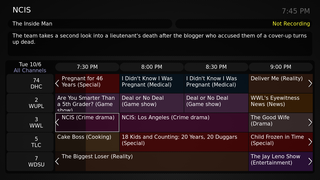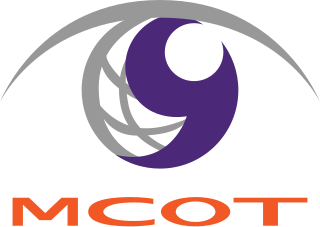
A television channel, or TV channel, is a terrestrial frequency or virtual number over which a television station or television network is distributed. For example, in North America, channel 2 refers to the terrestrial or cable band of 54 to 60 MHz, with carrier frequencies of 55.25 MHz for NTSC analog video (VSB) and 59.75 MHz for analog audio (FM), or 55.31 MHz for digital ATSC (8VSB). Channels may be shared by many different television stations or cable-distributed channels depending on the location and service provider

Very high frequency (VHF) is the ITU designation for the range of radio frequency electromagnetic waves from 30 to 300 megahertz (MHz), with corresponding wavelengths of ten meters to one meter. Frequencies immediately below VHF are denoted high frequency (HF), and the next higher frequencies are known as ultra high frequency (UHF).

Digital Video Broadcasting (DVB) is a set of international open standards for digital television. DVB standards are maintained by the DVB Project, an international industry consortium, and are published by a Joint Technical Committee (JTC) of the European Telecommunications Standards Institute (ETSI), European Committee for Electrotechnical Standardization (CENELEC) and European Broadcasting Union (EBU).

Terrestrial television or over-the-air television (OTA) is a type of television broadcasting in which the content is transmitted via radio waves from the terrestrial (Earth-based) transmitter of a TV station to a TV receiver having an antenna. The term terrestrial is more common in Europe and Latin America, while in Canada and the United States it is called over-the-air or simply broadcast. This type of TV broadcast is distinguished from newer technologies, such as satellite television, in which the signal is transmitted to the receiver from an overhead satellite; cable television, in which the signal is carried to the receiver through a cable; and Internet Protocol television, in which the signal is received over an Internet stream or on a network utilizing the Internet Protocol. Terrestrial television stations broadcast on television channels with frequencies between about 52 and 600 MHz in the VHF and UHF bands. Since radio waves in these bands travel by line of sight, reception is generally limited by the visual horizon to distances of 64–97 kilometres (40–60 mi), although under better conditions and with tropospheric ducting, signals can sometimes be received hundreds of kilometers distant.
Digital terrestrial television is a technology for terrestrial television where television stations broadcast television content in a digital format. DTTV is a major technological advance over analog television, and has largely replaced analog television broadcast, which had been in common use since the middle of the 20th century. Test broadcasts began in 1998 with the changeover to DTTV, also known as the Analog Switchoff (ASO) or Digital Switchover (DSO), which began in 2006 and is now complete in many countries. The advantages of digital terrestrial television are similar to those obtained by digitizing platforms such as cable TV, satellite, and telecommunications: more efficient use of radio spectrum bandwidth, provision of more television channels than analog, better quality images, and potentially lower operating costs for broadcasters.
The following tables show the frequencies assigned to broadcast television channels in various regions of the world, along with the ITU letter designator for the system used. The frequencies shown are for the analogue video and audio carriers. The channel itself occupies several megahertz of bandwidth. For example, North American channel 1 occupies the spectrum from 44 to 50 MHz. See Broadcast television systems for a table of signal characteristics, including bandwidth, by ITU letter designator.
DZRJ-DTV is a commercial independent digital-only television station based in Makati City, Metro Manila, Philippines. The station is the flagship TV property of Rajah Broadcasting Network, Inc., a broadcast company owned by long-time guitarist/musician Ramon "RJ" Jacinto. The station's broadcast facilities, shared with its AM and FM radio sisters, are located at the Ventures I Bldg., Makati Ave. cor. Gen. Luna St., Makati; DZRJ-DTV's transmitter facility is located at Merano Street, Brgy. San Roque, Antipolo City, Rizal Province.

MCOT Public Company Limited, formerly known as the Mass Communication Organization of Thailand, is a Thai state-owned public broadcaster. It owns and operates a number of radio and television stations in Thailand. It is based in Bangkok.
DWCP-DTV is a television station in Metro Manila, Philippines, serving as the flagship of the SolarFlix network. The station is owned by Southern Broadcasting Network, a subsidiary of Solar Entertainment Corporation. Its studios are located at the Third Floor Worldwide Corporate Center, Shaw Boulevard corner EDSA, Mandaluyong, while its hybrid digital transmitting facility is located at the Solar Entertainment Complex, along Nuestra Señora de la Paz Subdivision, Barangay Sta. Cruz, Antipolo, Rizal.

DZCE-TV is a television station in Metro Manila, Philippines, serving as the flagship of the INCTV network. Owned and operated by Christian Era Broadcasting Service International, a broadcast ministry of the Iglesia ni Cristo, the station maintains studio and transmitter facilities located at Milton Hills Subdivision, Redeemer St., Brgy. New Era, Quezon City.
Band I is a range of radio frequencies within the very high frequency (VHF) part of the electromagnetic spectrum. The first time there was defined "for simplicity" in Annex 1 of "Final acts of the European Broadcasting Conference in the VHF and UHF bands - Stockholm, 1961". Band I ranges from 47 to 68 MHz for the European Broadcasting Area, and from 54 to 88 MHz for the Americas and it is primarily used for television broadcasting in compliance with ITU Radio Regulations. With the transition to digital TV, most Band I transmitters have already been switched off.
CTS Education, Sports and Culture is a free-to-air television station in Taiwan, operated by Chinese Television System (CTS). The channel mainly broadcasts documentaries, arts and cultural programming, archival programming from the CTS library, and live sports coverage.
Analogue terrestrial television in the United Kingdom was originally the method by which the significant majority of viewers in the UK, the Channel Islands and the Isle of Man received television. Analogue terrestrial television broadcasts have fully ceased in the UK with Northern Ireland being the last region to have ceased transmission analogue terrestrial television broadcasts. Northern Ireland switched off the last analogue television signals, making all of the United Kingdom only capable of receiving digital television, in the early hours of 24 October, 2012. It has been completely replaced by digital terrestrial television and other non-terrestrial means as of the end of 2012.
Digital terrestrial television in the Philippines began in 2015 with the implementation of ISDB-T, currently coexisting with analog television that operates on the NTSC standard after the set analog switch-off (ASO) deadline encountered multiple postponements.

The digital television transition, also called the digital switchover (DSO), the analogue switch/sign-off (ASO), the digital migration, or the analogue shutdown, is the process in which older analogue television broadcasting technology is converted to and replaced by digital television. Conducted by individual nations on different schedules, this primarily involves the conversion of analogue terrestrial television broadcasting infrastructure to Digital terrestrial television (DTT), a major benefit being extra frequencies on the radio spectrum and lower broadcasting costs, as well as improved viewing qualities for consumers.
In Thailand, television broadcasting started on 24 June, 1955. Color telecasts were started in 1967, and full-time color transmissions were launched in 1975. As of November 2020, there are currently 21 digital (DVB-T2) TV channels in Thailand.
Television in Japan was introduced in 1939. However, experiments date back to the 1920s, with Kenjiro Takayanagi's pioneering experiments in electronic television. Television broadcasting was halted by World War II, after which regular television broadcasting began in 1950. After Japan developed the first HDTV systems in the 1960s, MUSE/Hi-Vision was introduced in the 1970s.

UHF television broadcasting is the use of ultra high frequency (UHF) radio for over-the-air transmission of television signals. UHF frequencies are used for both analog and digital television broadcasts. UHF channels are typically given higher channel numbers, like the US arrangement with VHF channels (initially) 1 to 13, and UHF channels (initially) numbered 14 to 83. Compared with an equivalent VHF television transmitter, to cover the same geographic area with a UHF transmitter requires a higher effective radiated power, implying a more powerful transmitter or a more complex antenna. However, the additional channels allow more broadcasters in a given region without causing objectionable mutual interference.

Television in North Korea is subject to the Korean Central Broadcasting Committee and controlled by the Propaganda and Agitation Department of the Workers' Party of Korea. A study in 2017 found that 98% of households had a television set. As of 2020, there are over-the-air broadcasts in both analogue and recently launched digital formats.









